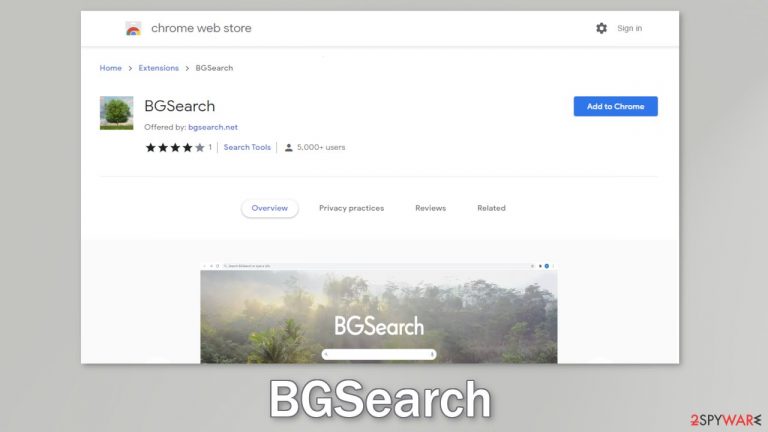BGSearch browser extension (virus) - Free Guide
BGSearch browser extension Removal Guide
What is BGSearch browser extension?
BGSearch changes the background of the homepage, and redirects users' queries to Bing

BGSearch is a bogus browser extension created to monetize users' activity. It changes the main settings, like the homepage, new tab address, and search engine. It can also start generating commercial content, like pop-ups, banners, and redirects. Such apps are often disguised as “handy” tools, and this one is no exception. In the description fraudsters say:
Light and minimal new tab that allows you to search by text or by voice and navigate easily to your favorite, recently visited sites.
in reality, the web-based app does not provide any benefits that are not available in a default browser It only changes the homepage background to nature pictures and redirects users' queries to Bing. There is no point in having this extension installed so you should remove it as soon as possible.
Browser plugins can also be used to collect browsing-related data, which means that crooks can monitor your activity and later profit from it. Crooks may also use rogue advertising networks that place ads leading to dangerous websites that try to fool people into providing personal information, downloading PUPs (potentially unwanted programs),[1] and malware.
| NAME | BGSearch |
| TYPE | Browser hijacker; potentially unwanted program |
| SYMPTOMS | When a browser gets hijacked, usually the main settings get changed – the homepage, new tab address, and search engine; additionally, users can experience an increased amount of commercial content |
| DISTRIBUTION | Shady websites, deceptive ads, redirects, freeware installations |
| DANGERS | The application might gather various browsing-related information, which raises many user security and privacy concerns |
| ELIMINATION | You can remove an unwanted extension in the settings of the browser; deploying professional security software to scan the machine is recommended |
| FURTHER STEPS | Use FortectIntego to try to repair any remaining damage and optimize the machine to fix performance issues |
Hijackers can be found on official web stores as well
Yes, you have read that right. Even though it is rare, some browser hijackers slip through an extensive review process. BGSearch, at the time of writing, is still available on the chrome web store. We previously wrote about hijackers, like Key Tag, Shiny Tab, and Pure Dark which were also distributed through the chrome web store.
That is why it is so important to do your research – read the reviews, look at the ratings, and the number of users the applications have. Choose the ones that have plenty of feedback, good ratings, and user numbers in the thousands. There is less of a chance that it will hijack your browser.
But users rarely find these applications while browsing through the web stores. Most of them have separate promotional websites that are spread through the Internet. Usually, those are shady sites that are full of deceptive ads and sneaky redirects because they are unregulated.
We ask our users to always be cautious while browsing the web. Do not click on random links, and visit suspicious websites. If you see an offer that seems too good to be true – it probably is. Always think twice before pressing “Install” and try to use official sources as much as possible.

Start the removal
The first thing you should do is go to your browser settings and check if you see any extensions with a similar name or suspicious-looking add-ons in general. You can follow our guide if you need help:
Google Chrome
- Open Google Chrome, click on the Menu (three vertical dots at the top-right corner) and select More tools > Extensions.
- In the newly opened window, you will see all the installed extensions. Uninstall all the suspicious plugins that might be related to the unwanted program by clicking Remove.

MS Edge:
- Select Menu (three horizontal dots at the top-right of the browser window) and pick Extensions.
- From the list, pick the extension and click on the Gear icon.
- Click on Uninstall at the bottom.

MS Edge (Chromium)
- Open Edge and click select Settings > Extensions.
- Delete unwanted extensions by clicking Remove.

Mozilla Firefox
- Open Mozilla Firefox browser and click on the Menu (three horizontal lines at the top-right of the window).
- Select Add-ons.
- In here, select unwanted plugin and click Remove.

Safari
- Click Safari > Preferences…
- In the new window, pick Extensions.
- Select the unwanted extension and select Uninstall.

Now that your machine is clear from intruders, you should get rid of all the data that might have been collected about you, while it was in your machine. For this, you need a different tool – FortectIntego, which is a multi-purpose maintenance software. It will fully clear your browsers from cookies and cache,[2] which will result in better performance of your machine. Besides that, it can fix various complicated system errors that are caused by corrupted files, and registry issues, which is especially helpful after a virus infection.
Additional security measures
The hijacking could have also been caused by a program. This most commonly happens when people do not pay attention during installation and browse through shady sites. If the previous removal method did not get rid of the intruder, you most likely have a potentially unwanted program performing tasks in the background.
In this case, simply removing the plugin from the browser will not help, and the application will keep messing up the settings until you completely eliminate it from your system. However, identifying the program responsible for hijacking your browser might be difficult if you have never done this before and if it is not named the same as the homepage.
SpyHunter 5Combo Cleaner and Malwarebytes can scan your machine, identify suspicious processes running in your machine, eliminate them, and prevent such infections in the future by giving you a warning before a malicious program can make any changes. If manual removal is what you still prefer, we have instructions for Windows and Mac machines:
Windows 10/8:
- Enter Control Panel into Windows search box and hit Enter or click on the search result.
- Under Programs, select Uninstall a program.

- From the list, find the entry of the suspicious program.
- Right-click on the application and select Uninstall.
- If User Account Control shows up, click Yes.
- Wait till uninstallation process is complete and click OK.

Windows 7/XP:
- Click on Windows Start > Control Panel located on the right pane (if you are Windows XP user, click on Add/Remove Programs).
- In Control Panel, select Programs > Uninstall a program.

- Pick the unwanted application by clicking on it once.
- At the top, click Uninstall/Change.
- In the confirmation prompt, pick Yes.
- Click OK once the removal process is finished.
Mac:
- From the menu bar, select Go > Applications.
- In the Applications folder, look for all related entries.
- Click on the app and drag it to Trash (or right-click and pick Move to Trash)

To fully remove an unwanted app, you need to access Application Support, LaunchAgents, and LaunchDaemons folders and delete relevant files:
- Select Go > Go to Folder.
- Enter /Library/Application Support and click Go or press Enter.
- In the Application Support folder, look for any dubious entries and then delete them.
- Now enter /Library/LaunchAgents and /Library/LaunchDaemons folders the same way and terminate all the related .plist files.

Crooks often disguise PUPs as handy tools that you would not even suspect. It could look like an antivirus, system optimizer, media player, or else. It is done so it would be more difficult for everyday users to get rid of them. They are most commonly spread through freeware[3] distribution platforms.
To minimize the risk of infection, always choose the “Custom” or “Advanced” installation methods, read the Privacy Policy, and Terms of Use. The most important step is to check the file list and untick the boxes next to any unrelated files to prevent them from installing.
How to prevent from getting browser hijacker
Stream videos without limitations, no matter where you are
There are multiple parties that could find out almost anything about you by checking your online activity. While this is highly unlikely, advertisers and tech companies are constantly tracking you online. The first step to privacy should be a secure browser that focuses on tracker reduction to a minimum.
Even if you employ a secure browser, you will not be able to access websites that are restricted due to local government laws or other reasons. In other words, you may not be able to stream Disney+ or US-based Netflix in some countries. To bypass these restrictions, you can employ a powerful Private Internet Access VPN, which provides dedicated servers for torrenting and streaming, not slowing you down in the process.
Data backups are important – recover your lost files
Ransomware is one of the biggest threats to personal data. Once it is executed on a machine, it launches a sophisticated encryption algorithm that locks all your files, although it does not destroy them. The most common misconception is that anti-malware software can return files to their previous states. This is not true, however, and data remains locked after the malicious payload is deleted.
While regular data backups are the only secure method to recover your files after a ransomware attack, tools such as Data Recovery Pro can also be effective and restore at least some of your lost data.
- ^ Potentially unwanted program. Wikipedia. The Free Encyclopedia.
- ^ 7 Differences between Cache and Cookies (with examples). Kingpinbrowser. Privacy Blog.
- ^ Tim Fisher. What Is Freeware?. Lifewire. Internet, Networking and Security.
